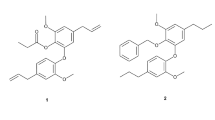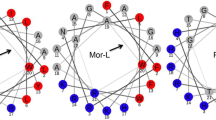Abstract
For medical use of proteins and peptide-based drugs, it is desirable to have small biologically active sequences because they improve stability, reduce side effects, and production costs. Several plant defensins have their biological activities imparted by a sequence named γ-core. Vu-Def, a Vigna unguiculata defensin, has activity against Leishmania amazonensis, which is one etiological agent of leishmaniasis and for which new drugs are needed. Our intention was to understand if the region comprising the Vu-Def γ-core is responsible for the biological activity against L. amazonensis and to unveil its mechanism of action. Different microbiological assays with L. amazonensis in the presence of the synthetic peptide A36,42,44γ32-46Vu-Def were done, as well as ultrastructural and fluorescent analyses. A36,42,44γ32-46Vu-Def showed biological activity similar to Vu-Def. A36,42,44γ32-46Vu-Def (74 µM) caused 97% inhibition of L. amazonensis culture and parasites were unable to regrow in fresh medium. The cells of the treated parasites showed morphological alterations by ultrastructural analysis and fluorescent labelings that corroborate with the data of the organelles alterations. The general significance of our work is based on the description of a small synthetic peptide, A36,42,44γ32-46Vu-Def, which has activity on L. amazonensis and that the interaction between A36,42,44γ32-46Vu-Def-L. amazonensis results in parasite inhibition by the activation of an apoptotic-like cell death pathway.








Similar content being viewed by others
References
Akbari M, Oryan A, Hatam G (2017) Application of nanotechnology in treatment of leishmaniasis: a review. Acta Trop 172:86–90. https://doi.org/10.1016/j.actatropica.2017.04.029
Altschul SF, Gish W, Miller W, Myers EW, Lipman DJ (1990) Basic local alignment search tool. J Mol Biol 215:403–410. https://doi.org/10.1016/S0022-2836(05)80360-2
Ashibara T, Baserga R (1979) Cell synchronization. Methods Enzymol 58:248–262. https://doi.org/10.1016/S0076-6879(79)58141-5
Baskić D, Popović S, Ristić P, Arsenijević NN (2006) Analysis of cycloheximide-induced apoptosis in human leukocytes: fluorescence microscopy using annexin V/propidium iodide versus acridin orange/ethidium bromide. Cell Biol Int 30:924–932. https://doi.org/10.1016/j.cellbi.2006.06.016
Bjellqvist B, Hughes GJ, Pasquali C, Paquet N, Ravier F, Sanchez JC, Frutiger S, Hochstrasser D (1993) The focusing positions of polypeptides in immobilized pH gradients can be predicted from their amino acid sequences. Electrophoresis 14:1023–1031. https://doi.org/10.1002/elps.11501401163
Bjellqvist B, Basse B, Olsen E, Celis JE (1994) Reference points for comparisons of two-dimensional maps of proteins from different human cell types defined in a pH scale where isoelectric points correlate with polypeptide compositions. Electrophoresis 15:529–539. https://doi.org/10.1002/elps.1150150171
Carvalho AO, Gomes VM (2011) Plant defensins and defensin-like peptides—biological activities and biotechnological applications. Curr Pharm Des 17:4270–4293. https://doi.org/10.2174/138161211798999447
Carvalho LP, Melo EJT (2018) intracellular development of Trypanosoma cruzi in the presence of metals. J Parasit Dis 42:372. https://doi.org/10.1007/s12639-018-1010-2
Carvalho CS, Melo EJ, Tenório RP, Góes AJ (2010) Anti-parasitic action and elimination of intracellular Toxoplasma gondii in the presence of novel thiosemicarbazone and its 4-thiazolidinone derivatives. Braz J Med Biol Res 43:139–149. https://doi.org/10.1590/S0100-879X2009005000038
Cools TL, Struyfs C, Drijfhout JW, Kucharíková S, Romero CL, Van Dijck P, Ramada MHS, Bloch C, Cammue BPA, Thevissen K (2017) A linear 19-mer plant defensin-derived peptide acts synergistically with caspofungin against Candida albicans biofilms. Front Microbiol 8:2051. https://doi.org/10.3389/fmicb.2017.02051
de Figueiredo RC, Soares MJ (2000) Low temperature blocks fluid-phase pinocytosis and receptor-mediated endocytosis in Trypanosoma cruzi epimastigotes. Parasitol Res 86:413–418
de Samblanx GW, Goderis IJ, Thevissen K, Raemaekers R, Fant F, Borremans F, Acland DP, Osborn RW, Patel S, Broekaert WF (1997) Mutational analysis of a plant defensin from radish (Raphanus sativus L.) reveals two adjacent sites important for antifungal activity. J Biol Chem 272:1171–1179. https://doi.org/10.1074/jbc.272.2.1171
Fant F, Vranken WF, Borremans FAM (1999) The three-dimensional solution structure of Aesculus hippocastanum antimicrobial protein 1 determined by 1H nuclear magnetic resonance. Proteins 37:388–403. https://doi.org/10.1002/(SICI)1097-0134(19991115)37:3%3c388:AID-PROT7%3e3.0.CO;2-F
Fardin JM, Carvalho LP, Nascimento VV, Melo EJT, Gomes VM, Machado OLT, Vieira-Silva FC, Carvalho AO (2016) Biochemical purification of proteins from Bertholletia excelsa seeds and their antileishmanial action in vitro. World J Pharm Res 5:233–300. https://doi.org/10.20959/wjpr20167-6609
Fázio MA, Oliveira VX, Bulet P, Miranda MTM, Daffre S, Miranda A (2006) Structure-activity relationship studies of gomesin: importance of the disulfide bridges for conformation, bioactivities, and serum stability. Biopolymers 84:205–218. https://doi.org/10.1002/bip.20396
Figueira TN, Oliveira FD, Almeida I, Mello ÉO, Gomes VM, Castanho MARB, Gaspar D (2017) Challenging metastatic breast cancer with the natural defensin PvD1. Nanoscale 9:16887–16899. https://doi.org/10.1039/C7NR05872A
Gasteiger E, Hoogland C, Gattiker A, Duvaud S, Wilkins MR, Appel RD, Bairoch A (2005) Protein identification and analysis tools on the ExPASy server. The proteomics protocols handbook. Humana Press, Totowa, pp 571–607. https://doi.org/10.1385/1-59259-890-0:571
Hayes BME, Bleackley MR, Anderson MA, van der Weerden NL (2018) The plant defensin NaD1 enters the cytoplasm of Candida albicans via endocytosis. J Fungi 4:20. https://doi.org/10.3390/jof4010020
Jha S, Chattoo BB (2010) Expression of a plant defensin in rice confers resistance to fungal phytopathogens. Transgenic Res 19:373–384. https://doi.org/10.1007/s11248-009-9315-7
Johansson J, Gudmundsson GH, Rottenberg ME, Berndt KD, Agerberth B (1998) Conformation-dependent antibacterial activity of the naturally occurring human peptide LL-37. J Biol Chem 273:3718–3724. https://doi.org/10.1074/jbc.273.6.3718
Laskowski RA (1993) PROCHECK: a program to check the stereochemical quality of protein structures. J Appl Cryst 26:283–291. https://doi.org/10.1107/S0021889892009944
Lobo DS, Pereira IB, Fragel-Madeira L, Medeiros LN, Cabral LM, Faria J, Bellio M, Campos RC, Linden R, Kurtenbach E (2007) Antifungal Pisum sativum defensin 1 interacts with Neurospora crassa cyclin F related to the cell cycle. Biochemistry 46:987–996. https://doi.org/10.1021/bi061441j
Mangoni ML, Saugar M, Dellisanti M, Barra D, Simmaco M, Rivas L, Andrea OS, Molecolari P (2005) Temporins, small antimicrobial peptides with leishmanicidal activity. J Biol Chem 280:984–990. https://doi.org/10.1074/jbc.M410795200
McGwire BS, Kulkarni MM (2010) Interactions of antimicrobial peptides with Leishmania and trypanosomes and their functional role in host parasitism. Exp Parasitol 126:397–405. https://doi.org/10.1016/j.exppara.2010.02.006
Mukherjee SB, Das M, Sudhandiran G, Shaha C (2002) Increase in cytosolic Ca2+ levels through the activation of non-selective cation channels induced by oxidative stress causes mitochondrial depolarization leading to apoptosis-like death in Leishmania donovani promastigotes. J Biol Chem 277:24717–24727. https://doi.org/10.1074/jbc.M201961200
Neto RLM, Sousa LMA, Dias CS, Filho JMB, Oliveira MR, Figueiredo RC (2011) Morphological and physiological changes in Leishmania promastigotes induced by yangambin, a lignan obtained from Ocotea duckei. Exp Parasitol 127:215–221. https://doi.org/10.1016/j.exppara.2010.07.020
Pace D (2014) Leishmaniasis. J Infect 69:S10–S18. https://doi.org/10.1016/j.jinf.2014.07.016
Pelegrini B, Perseghini R, Silva ON, Franco L, Maria F (2011) Antibacterial peptides from plants: what they are and how they probably work. Biochem Res Int 2011:250349. https://doi.org/10.1155/2011/250349
Reece SE, Pollitt LC, Colegrave N, Gardner A (2011) The meaning of death: evolution and ecology of apoptosis in protozoan parasites. PLoS Pathog 7:e1002120. https://doi.org/10.1371/journal.ppat.1002320
Rodrigues IA, Azevedo MMB, Chaves FCM, Alviano CS, Alviano DS, Vermelho AB (2014) Arrabidaea chica hexanic extract induces mitochondrion damage and peptidase inhibition on Leishmania spp. Biomed Res Int 2014:985171. https://doi.org/10.1155/2014/985171
Romestand B, Molina F, Richard V, Roch P, Granier C (2003) Key role of the loop connecting the two beta strands of mussel defensin in its antimicrobial activity. Eur J Biochem 270:2805–2813. https://doi.org/10.1046/j.1432-1033.2003.03657.x
Sagaram US, Pandurangi R, Kaur J, Smith TJ, Shah DM (2011) Structure-activity determinants in antifungal plant defensins MsDef1 and MtDef4 with different modes of action against Fusarium graminearum. PLoS One 6:e18550. https://doi.org/10.1371/journal.pone.0018550
Šali A, Blundell T (1993) Comparative protein modelling by satisfaction of spatial restraints. J Mol Biol 234:779–815
Santos IS, Carvalho AO, de Souza-Filho GA, do Nascimento VV, Machado OLT, Gomes VM (2010) Purification of a defensin isolated from Vigna unguiculata seeds, its functional expression in Escherichia coli, and assessment of its insect α-amylase inhibitory activity. Protein Expr Purif 71:8–15. https://doi.org/10.1016/j.pep.2009.11.008
Sarkar P, Jana K, Sikdar SR (2017) Overexpression of biologically safe Rorippa indica defensin enhances aphid tolerance in Brassica juncea. Planta 246:1029–1044. https://doi.org/10.1007/s00425-017-2750-4
Schaaper WMM, Posthuma GA, Meloen RH, Plasman HH, Sijtsma L, van Amerongen A, Fant F, Borremans FAM, Thevissen K, Broekaert WF (2001) Synthetic peptides derived from the β2–β3 loop of Raphanus sativus antifungal protein 2 that mimic the active site. J Pept Res 57:409–418. https://doi.org/10.1034/j.1399-3011.2001.00842.x
Sels J, Mathys J, De Coninck BMA, Cammue BPA, De Bolle MFC (2008) Plant pathogenesis-related (PR) proteins: a focus on PR peptides. Plant Physiol Biochem 46:941–950. https://doi.org/10.1016/j.plaphy.2008.06.011
Seo M-D, Won H-S, Kim J-H, Mishig-Ochir T, Lee B-J (2012) Antimicrobial peptides for therapeutic applications: a review. Molecules 17:12276–12286. https://doi.org/10.3390/molecules171012276
Soares JR, Melo JET, da Cunha M, Fernandes KVS, Taveira GB, da Silva Pereira L, Pimenta S, Trindade FG, Regente M, Pinedo M, de la Canal L, Gomes VM, Carvalho AO (2017) Interaction between the plant ApDef1defensin and Saccharomyces cerevisiae results in yeast death through a cell cycle- and caspase-dependent process occurring via uncontrolled oxidative stress. Biochim Biophys Acta Gen Subj 1861:3429–3443. https://doi.org/10.1016/j.bbagen.2016.09.005
Song X, Zhang M, Zhou Z, Gong W (2011) Ultra-high resolution crystal structure of a dimeric defensin SPE10. FEBS Lett 585:300–306. https://doi.org/10.1016/j.febslet.2010.12.039
Souza GS, Nascimento VV, Carvalho LP, Melo EJT, Fernandes KV, Machado OLT, Retamal CA, Gomes VM, Carvalho AO (2013) Activity of recombinant and natural defensins from Vigna unguiculata seeds against Leishmania amazonensis. Exp Parasitol 135:116–125. https://doi.org/10.1016/j.exppara.2013.06.005
Souza GS, Carvalho LP, Melo EJT, Gomes VM, Carvalho AO (2018) The toxic effect of Vu-Defr, a defensin from Vigna unguiculata seeds, on Leishmanina amazonensis is associated with reactive oxygen species production, mitochondria dysfunction, and plasma membrane perturbation. Can J Microbiol 64:455–464. https://doi.org/10.1139/cjm-2018-0095
Tavares PM, Thevissen K, Cammue BPA, Franc IEJA, Barreto-Bergter E, Taborda CP, Marques AF, Rodrigues ML, Nimrichter L (2008) In vitro activity of the antifungal plant defensin RsAFP2 against Candida isolates and its in vivo efficacy in prophylactic murine models of candidiasis. Antimicrob Agents Chemother 52:4522–4525. https://doi.org/10.1128/AAC.00448-08
Terras FR, Goderis IJ, Van Leuven F, Vanderleyden J, Cammue BP, Broekaert WF (1992) In vitro antifungal activity of a radish (Raphanus sativus L.) seed protein homologous to nonspecific lipid transfer proteins. Plant Physiol 100:1055–1058. https://doi.org/10.1104/pp.100.2.1055
Thevissen K, Kristensen H, Thomma BPHJ, Cammue BPA, François EJA (2007) Therapeutic potential of antifungal plant and insect defensins. Drug Discov Today 12:21–22. https://doi.org/10.1016/j.drudis.2007.07.016
Torrent M, Pulido D, Rivas L, Andreu D (2012) Antimicrobial peptide action on parasites. Curr Drug Targets 13:1138–1147. https://doi.org/10.2174/138945012802002393
Uchôa HB, Jorge GE, Da Silveira NJF, Camera JC, Canduri F, De Azevedo WF (2004) Parmodel: a web server for automated comparative modeling of proteins. Biochem Biophys Res Commun 325:1481–1486. https://doi.org/10.1016/j.bbrc.2004.10.192
van der Weerden NL, Marilyn AA (2013) Plant defensins: common fold, multiple functions. Fungal Biol Rev 26:121–131. https://doi.org/10.1016/j.fbr.2012.08.004
Vieira MEB, Vasconcelos IM, Machado OLT, Gomes VM, Carvalho AO (2015) Isolation, characterization and mechanism of action of an antimicrobial peptide from Lecythis pisonis seeds with inhibitory activity against Candida albicans. Acta Biochim Biophys Sin 47:716–729. https://doi.org/10.1093/abbs/gmv071
Yount NY, Yeaman MR (2004) Multidimensional signatures in antimicrobial peptides. Proc Natl Acad Sci USA 101:7363–7368. https://doi.org/10.1073/pnas.0401567101
Acknowledgements
We acknowledge Luiz Carlos Dutra de Souza and Valéria Miguelote Kokis for their technical support. This work has received financial support of the Brazilian agencies Conselho Nacional de Desenvolvimento Cientifico e Tecnológico (CNPq), Fundação de Amparo a Pesquisa do Estado do Rio de Janeiro (FAPERJ, process no. E-26/102.981/2012-Bolsa; process no. E-26/202.760/2018-Bolsa), and the support of Universidade Estadual do Norte Fluminense. This study was financed in part by the Coordenação de Aperfeiçoamento de Pessoal de Nível Superior-Brasil (CAPES)-Finance Code 001.
Author information
Authors and Affiliations
Contributions
GSS and LPC performed the experiments; FCVS prepared the modeling; AOC and OLTM participated in the peptide design; EJTM, VMG and AOC participated in the protozoan experimental design and data analysis; GSS and AOC contributed to the writing of the manuscript.
Corresponding author
Ethics declarations
Conflict of interest
The authors declare that they have no competing financial interests.
Human and animal rights statement
This article does not contain any studies with human participants or animals performed by any of the authors.
Additional information
Handling Editor: J. Broos.
Publisher's Note
Springer Nature remains neutral with regard to jurisdictional claims in published maps and institutional affiliations.
Electronic supplementary material
Below is the link to the electronic supplementary material.
Rights and permissions
About this article
Cite this article
Souza, G.S., de Carvalho, L.P., de Melo, E.J.T. et al. A synthetic peptide derived of the β2–β3 loop of the plant defensin from Vigna unguiculata seeds induces Leishmania amazonensis apoptosis-like cell death. Amino Acids 51, 1633–1648 (2019). https://doi.org/10.1007/s00726-019-02800-8
Received:
Accepted:
Published:
Issue Date:
DOI: https://doi.org/10.1007/s00726-019-02800-8




